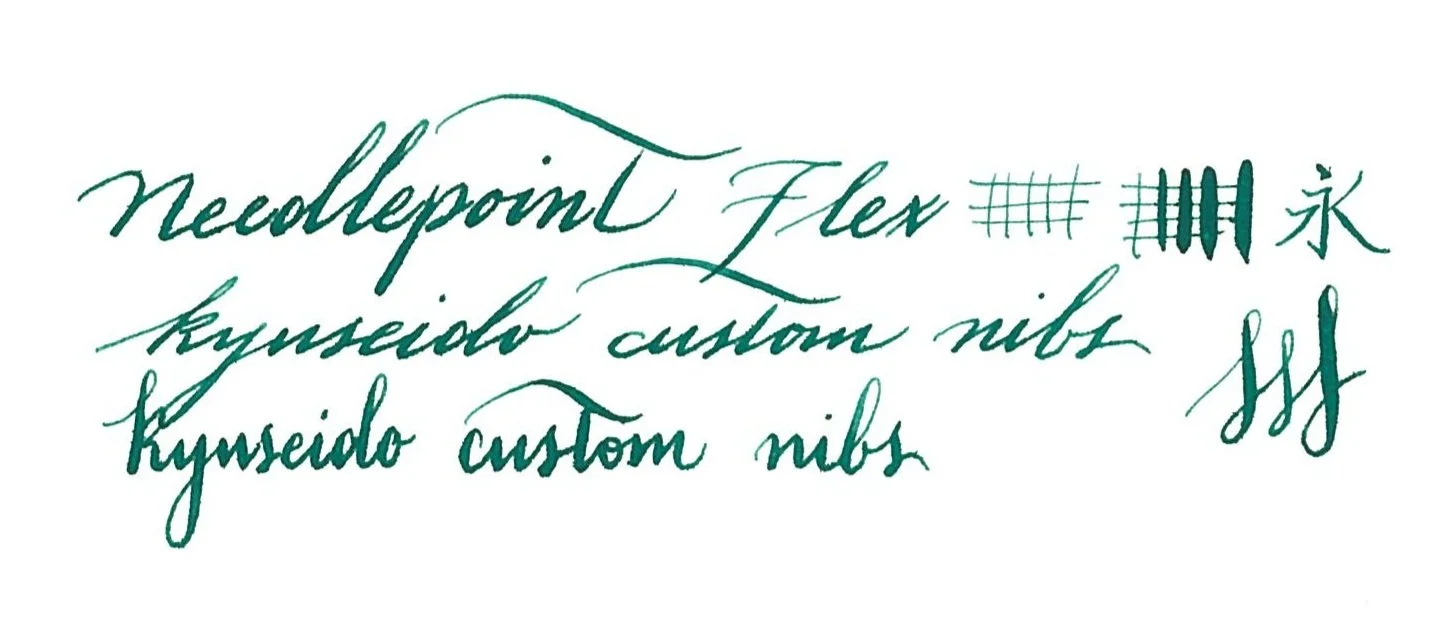Flex
Flex nibs are specialty tools of pointed pen calligraphy and art. However, there are many misconceptions around flex nibs, and even products that are marketed as flex nibs but do not perform as expected.
Firstly, it is important to distinguish the difference between bounce and spread. Many mass produced flex nibs are able to achieve bounce, which makes a nib lift off of it’s feed and therefore feel softer than a regular nib. However, as tools of calligraphy, a true flex nib must also exhibit the qualities of spread, in which the tines move away from each other when pressure is applied.
Spread is much more difficult to achieve, and few nibs on the market are able to boast about spread in their flex nibs. Even if a nib is marketed as a flex nib, it cannot perform it’s intended function as a tool of calligraphy without spread. But spread is a dangerous task to achieve, and a common joke in the fountain pen community is that “all nibs can flex at least once”. Customizing a nib to achieve spread is to push the nib beyond it’s intended purpose and must be approached with care.
Based on our research, there are several key factors in creating spread. The first is the alloy used in the nib. Though this may be contentious, it seems evident that the alloy of the gold is of utmost importance. For example, it is common knowledge that gold is a soft material, and therefore needs to be mixed with other elements in order to create suitable writing nibs. Based on conventional wisdom, the higher the carat the softer the gold, and therefore the softer the nib. However, Sailor’s 21k nibs are some of the stiffest on the market. On the other hand, Pilot’s 14k soft nibs are extremely soft, even if the carat is lower than that of the Sailor.
The second factor is the geometry of the nib. As a rule of thumb, the length of the tine slit relative to the size of the nib plays a key factor. Kyuseido does not lengthen the tine slit because this damages the integrity of the metal and creates weak points that reduce the metal’s ability to snap back. Primarily, the amount of metal on the non-tine portion of the nib is significantly reduced, and therefore the stability of the metal to return to it’s original position is also significantly lowered. Kyuseido gets around this by slimming down the wings of the nib to create tighter and more streamlined tines in order to achieve flex. This allows us to keep as much of the nib’s original design and geometry as possible, while also modifying it enough to achieve much more spread than originally possible.
The final factor is the thickness of the material. When we studied vintage dip gold nibs, we found that the flexible gold dip nibs were designed with thicker material at the base of the nib which gradually becomes thinner closer to the tipping. Many modern nibs have a consistent thickness, which maintains integrity of the nib itself, but also creates a rigid writing experience. Kyuseido can thin certain nibs by carefully grinding off the surface of the nib to imitate the gradient found on the vintage dip gold nibs to achieve a modern wet noodle nib.
Flex nibs are all handmade, and even vintage flex nibs all had their own individual idiosyncrasies. It’s difficult to compare one flex nib to another, but a combination of the spread of the nib to create line variation and the controlled lift of the nib to make sure that the metal can keep it’s integrity are key elements to any true flex nib. What sets Kyuseido apart is our focus on the third and final aspect of a good flex experience, which is the snapback of the nib. By controlling the three factors that govern a nib’s flexibility, we strive to create flex nibs with fast and natural snapback in order to deliver the best calligraphy tool for fountain pens on the market.
-

Flex
Created for pointed pen calligraphy for an antique flair


